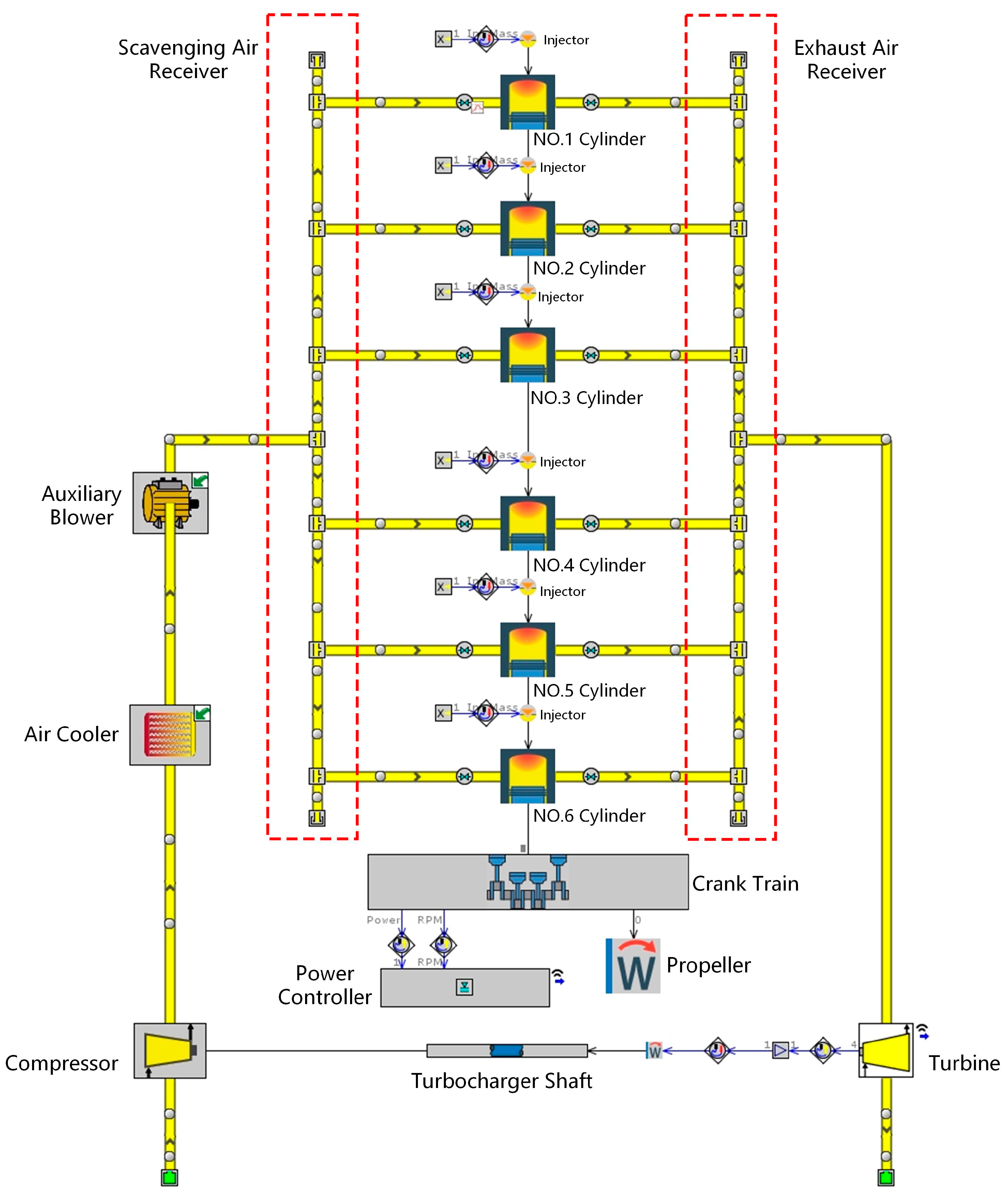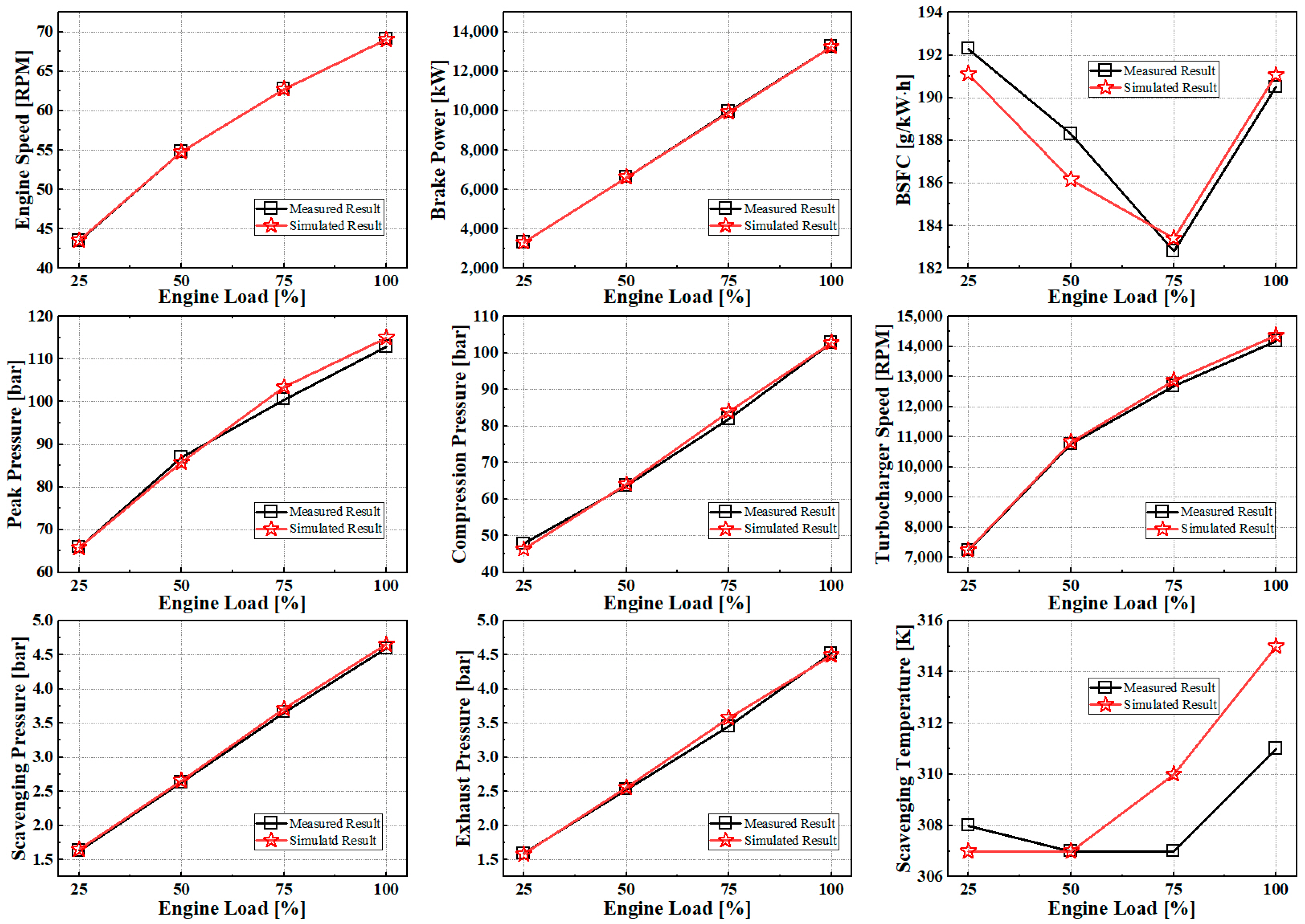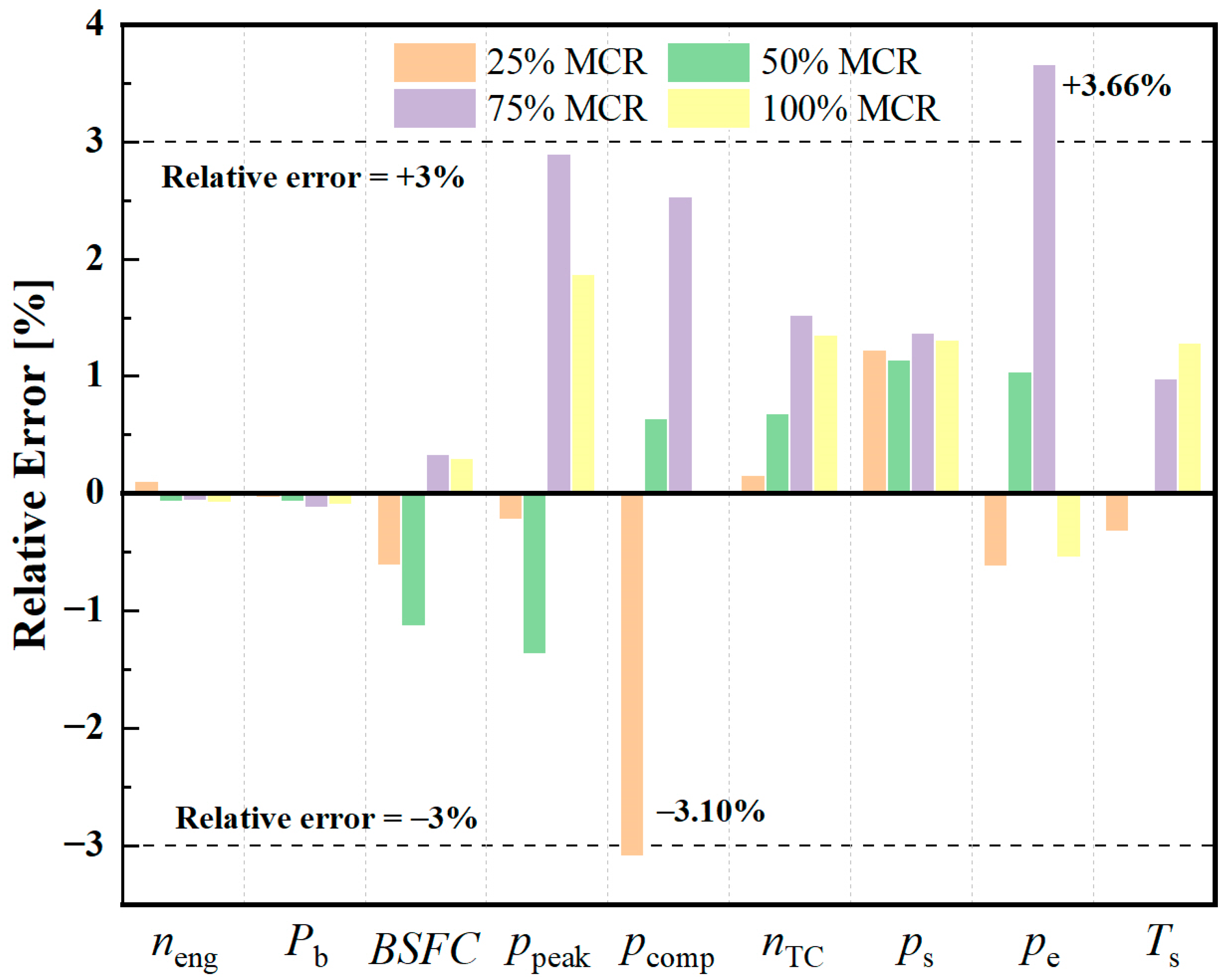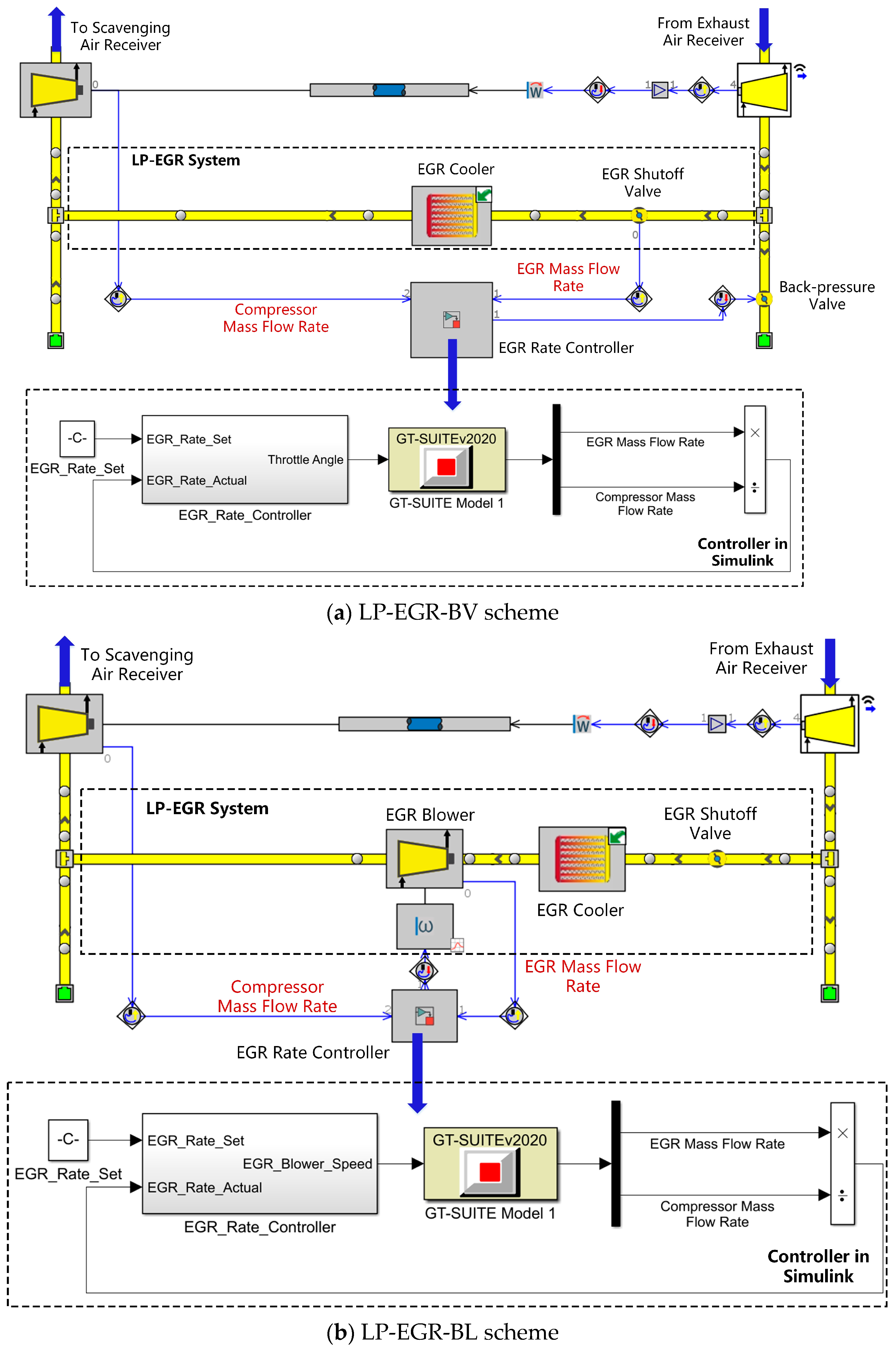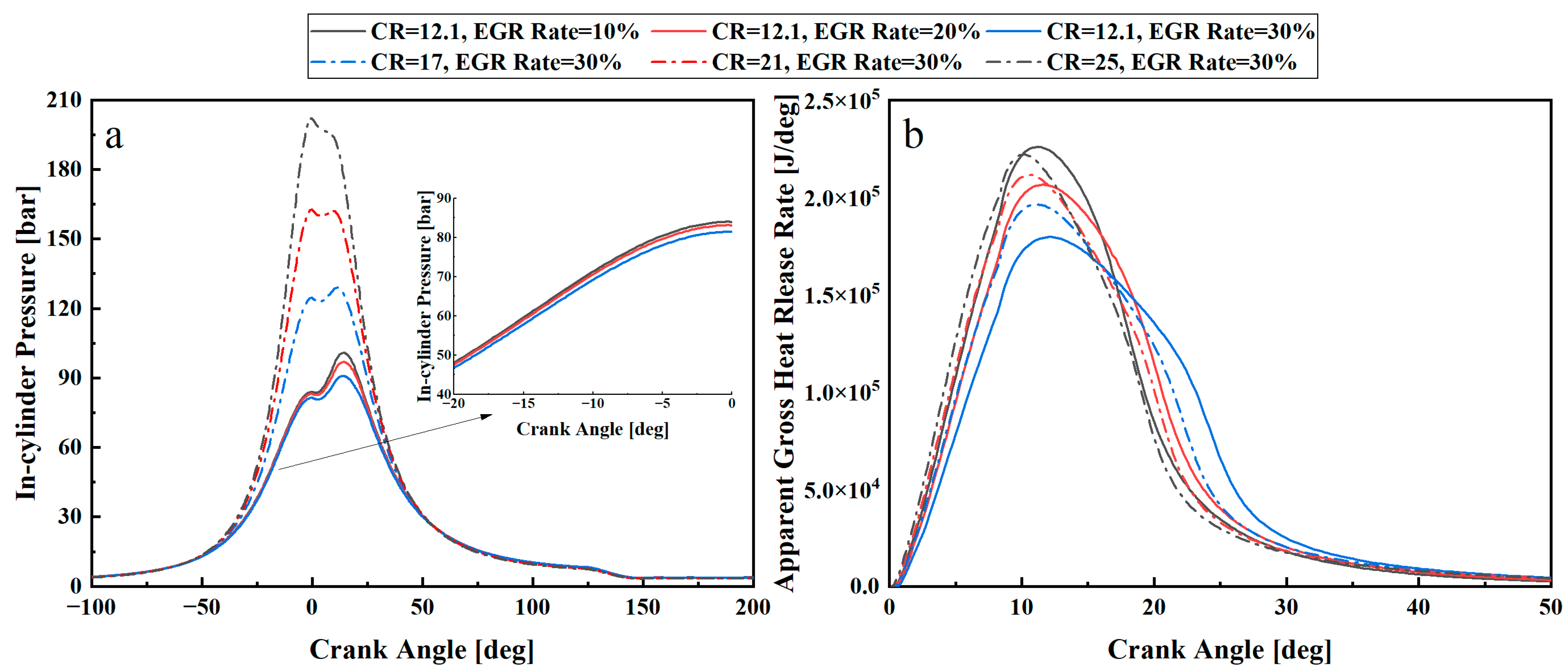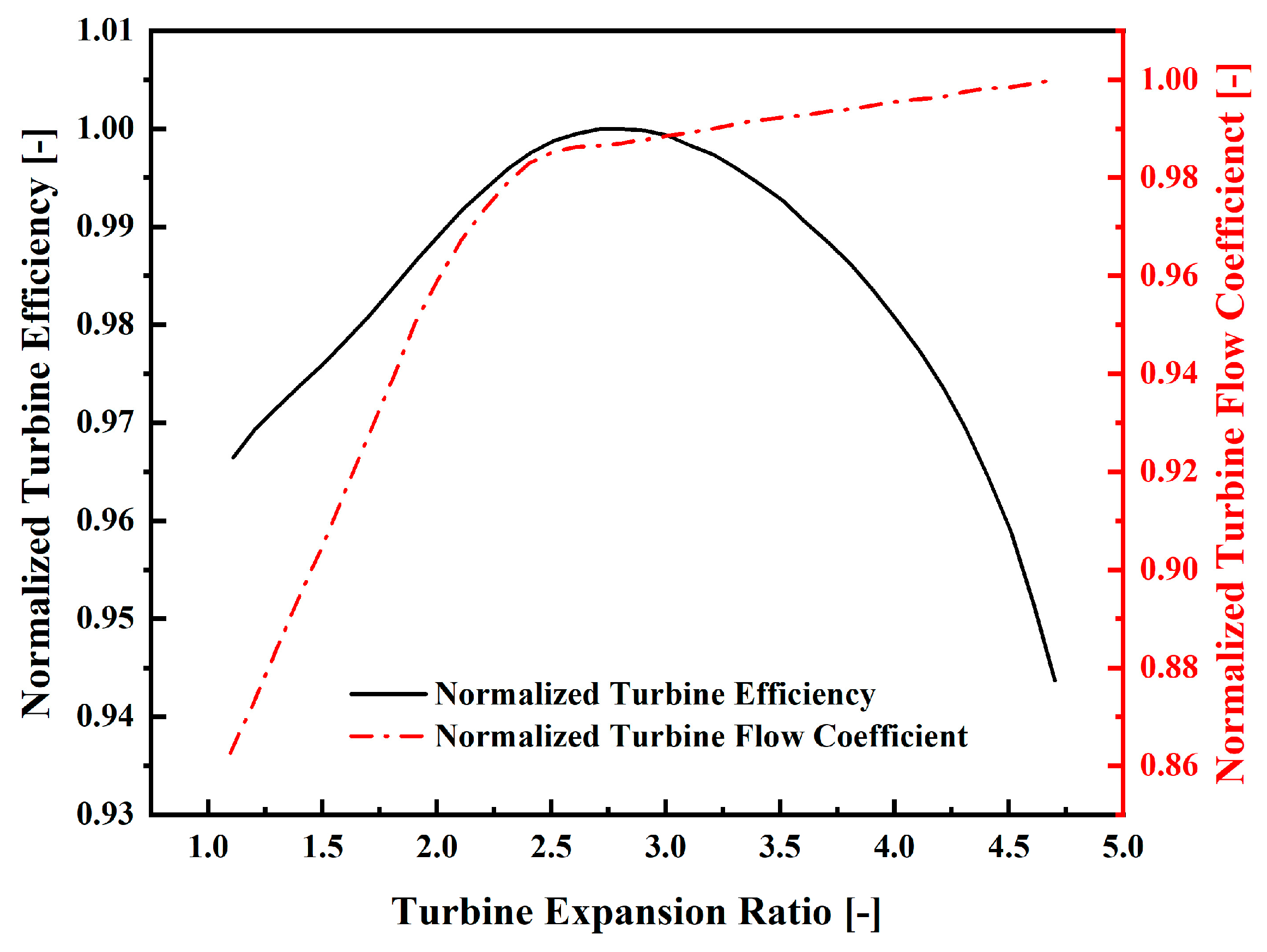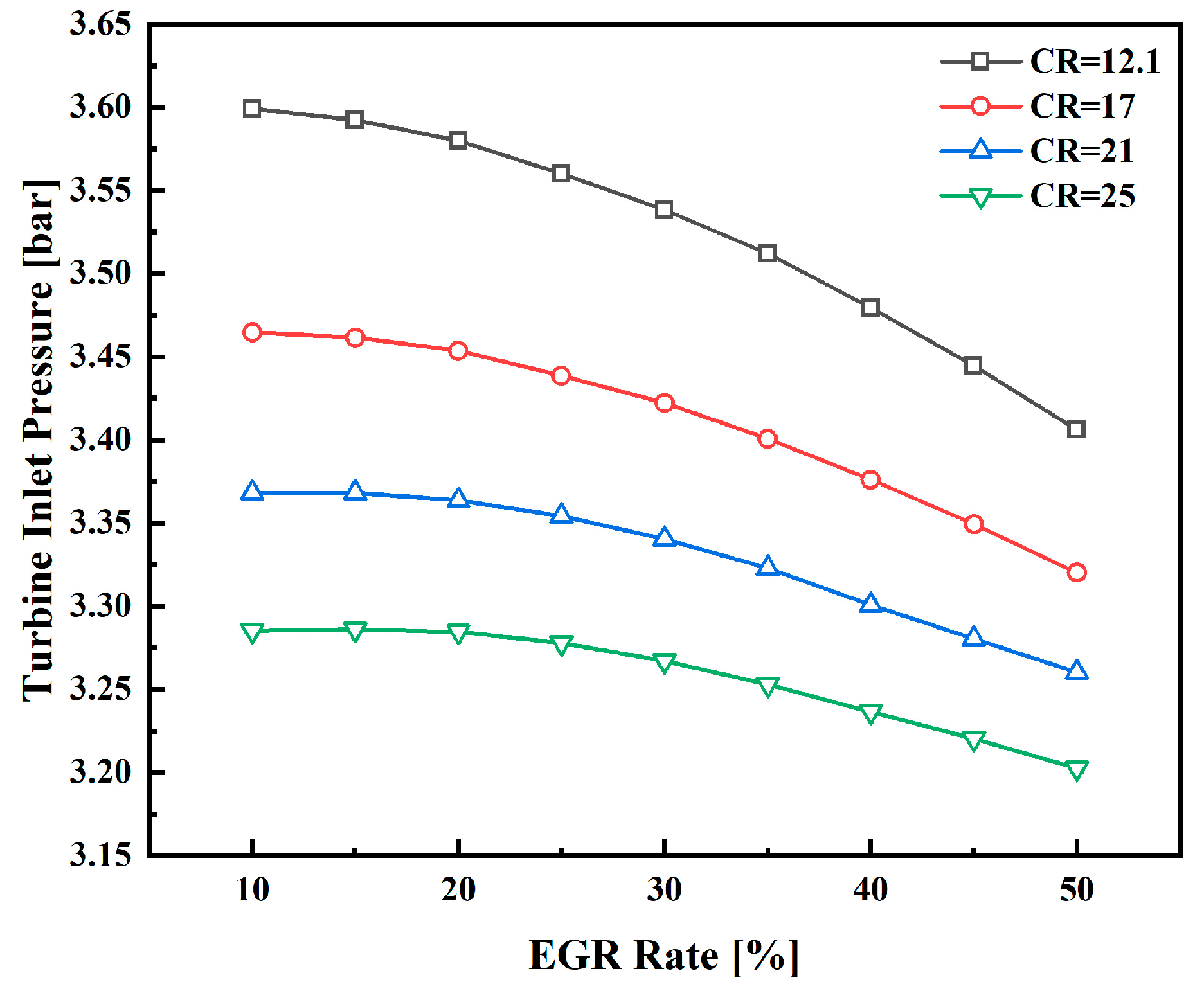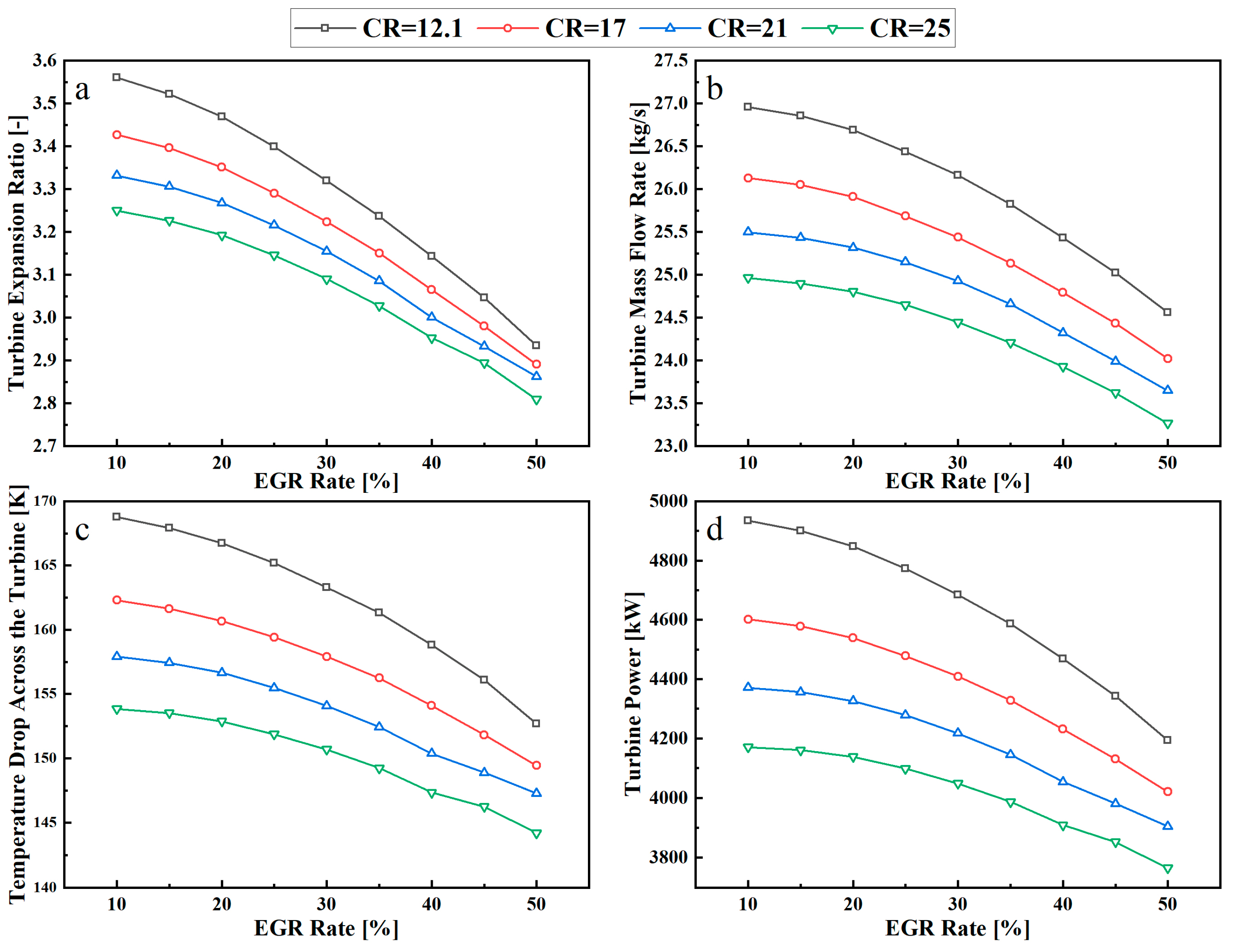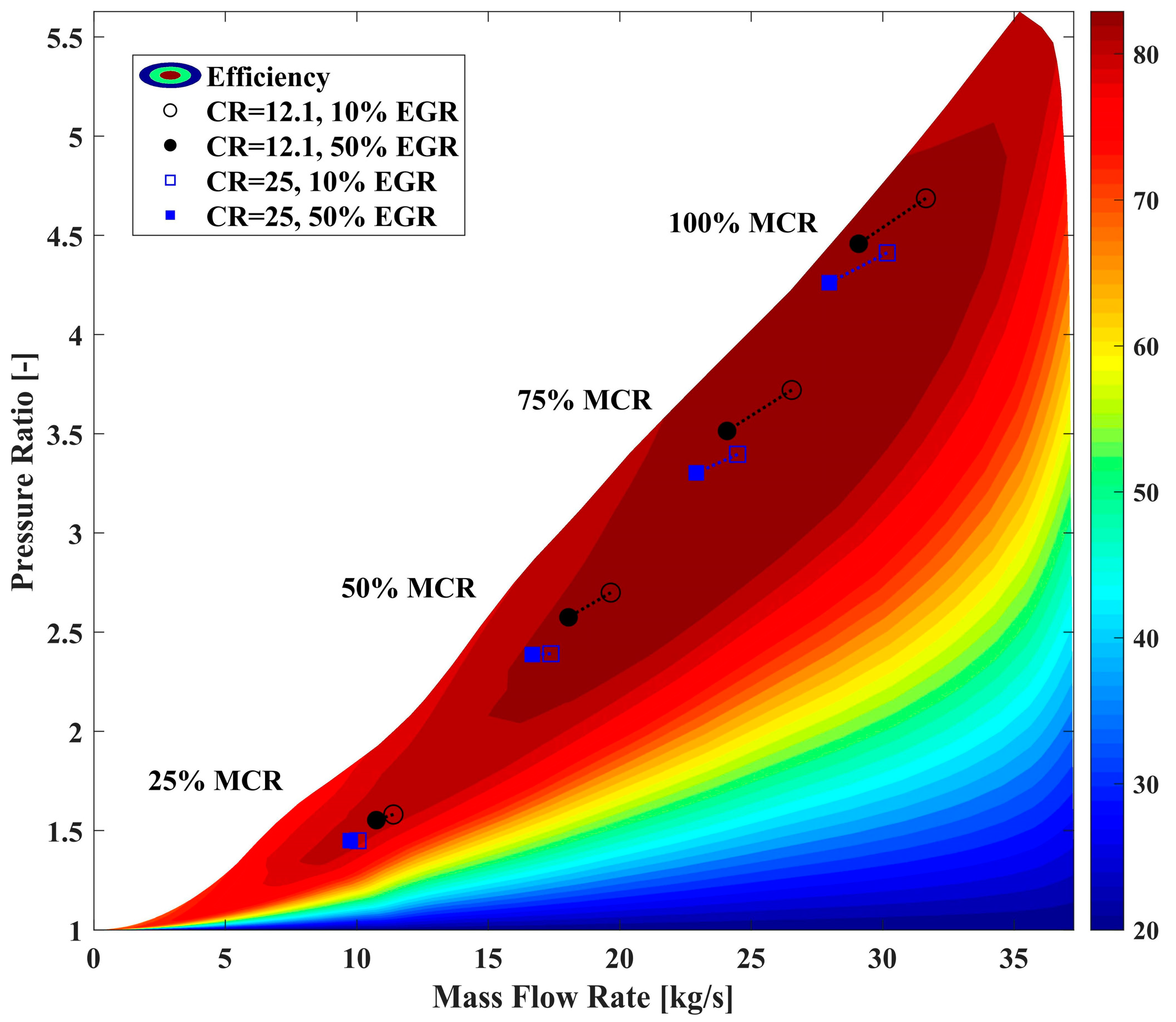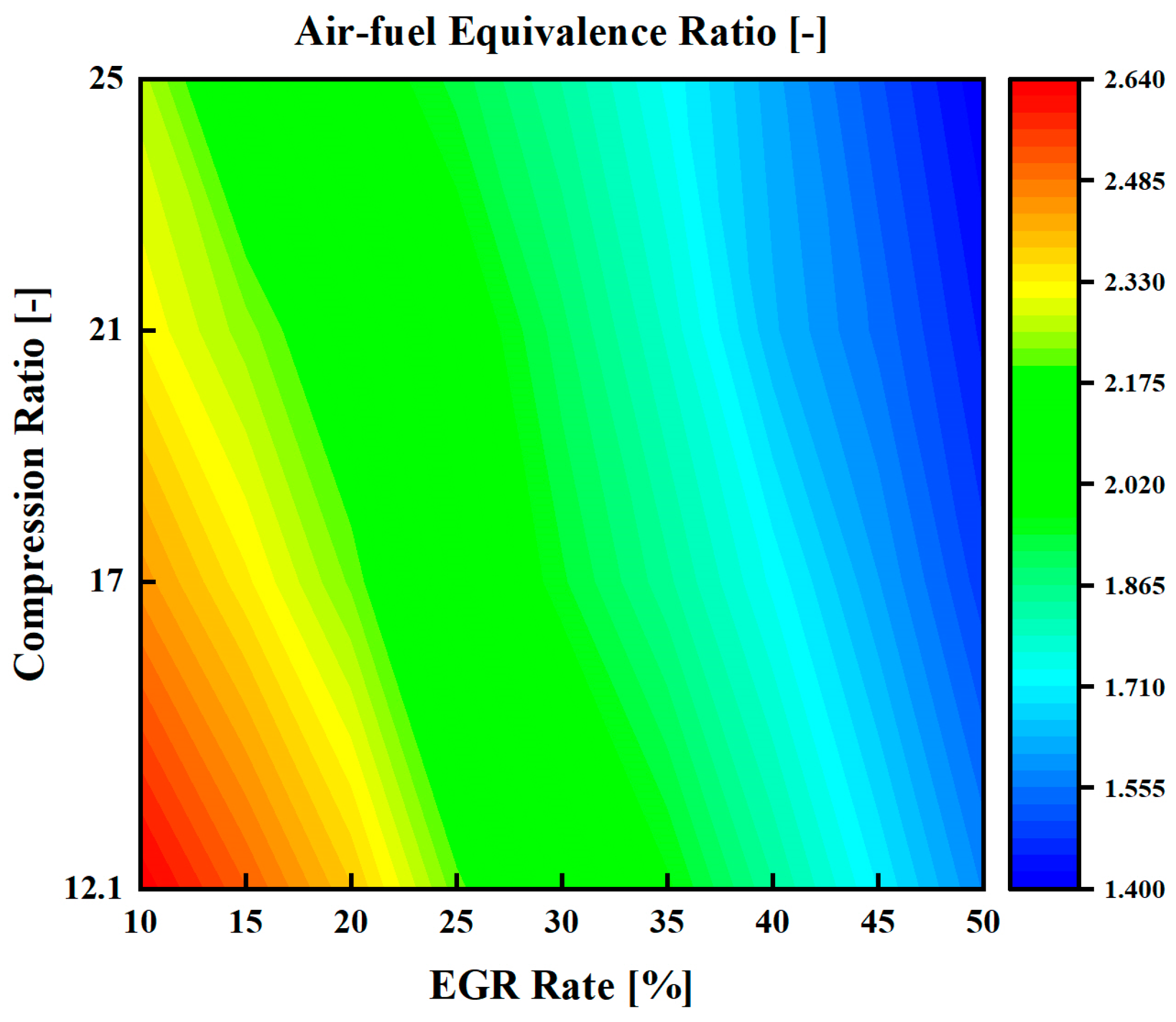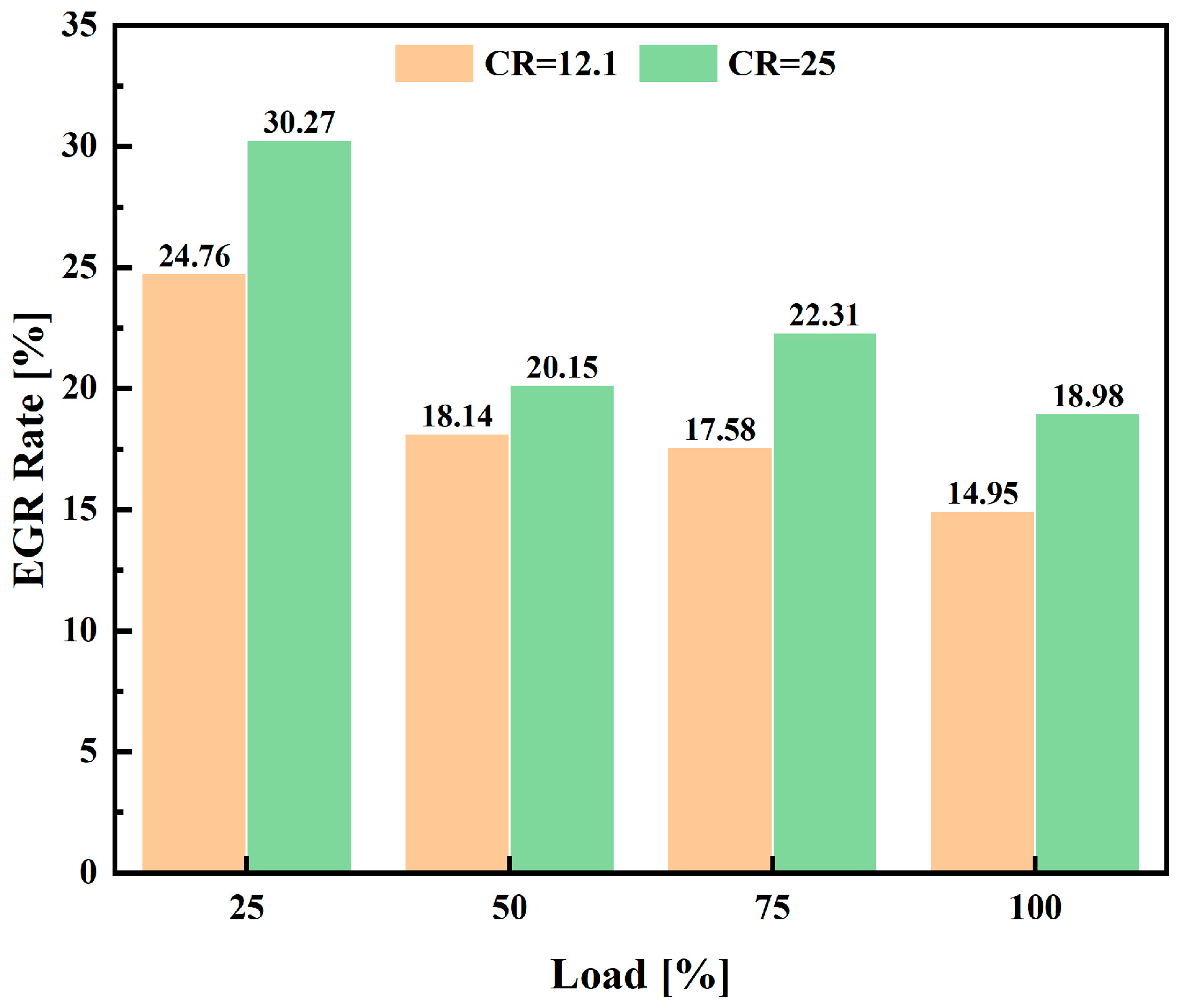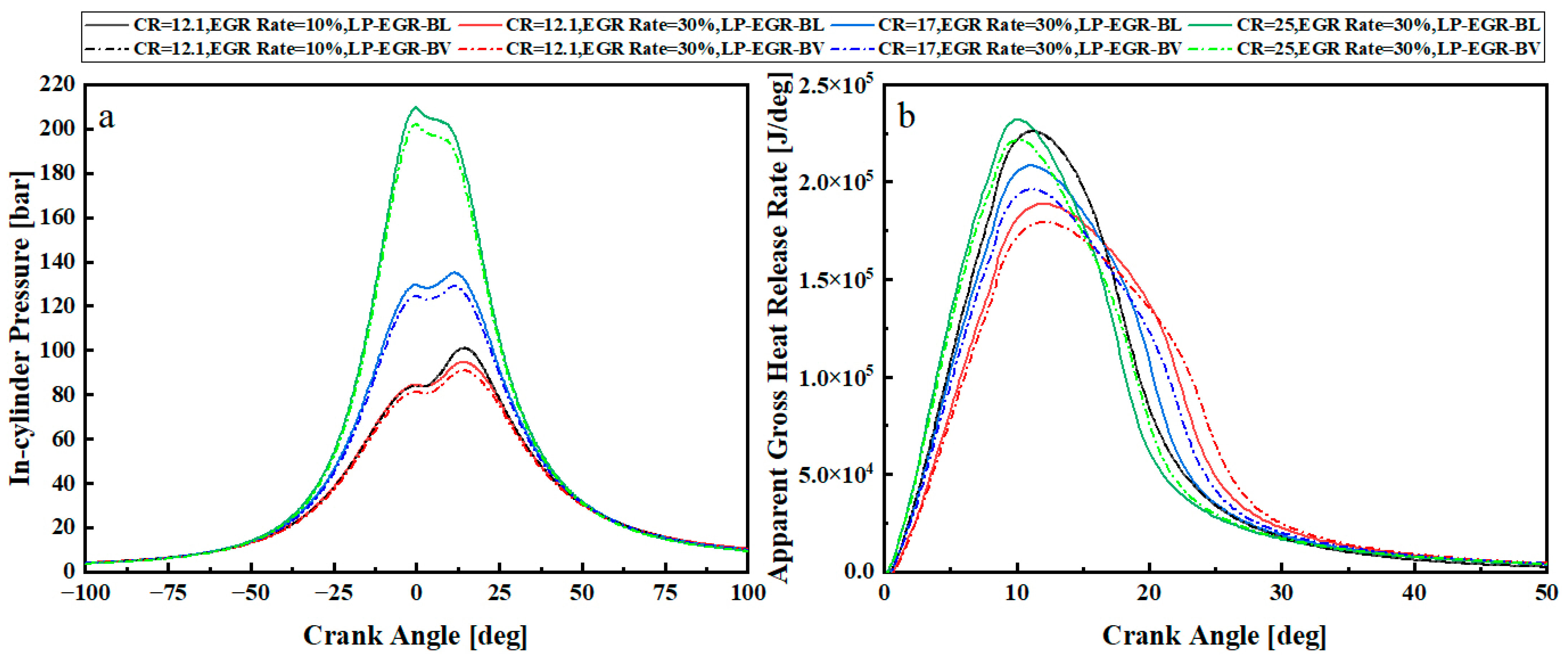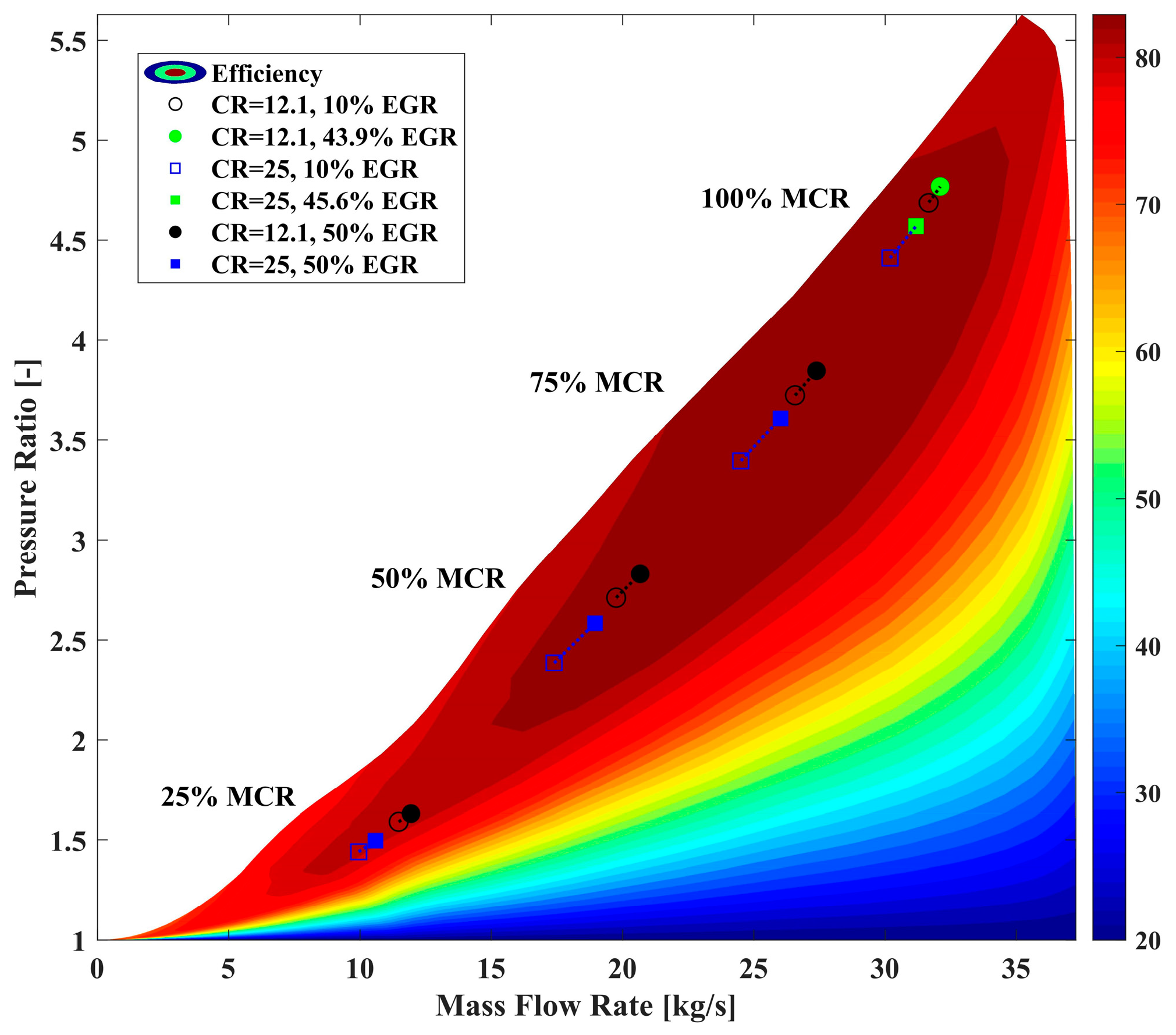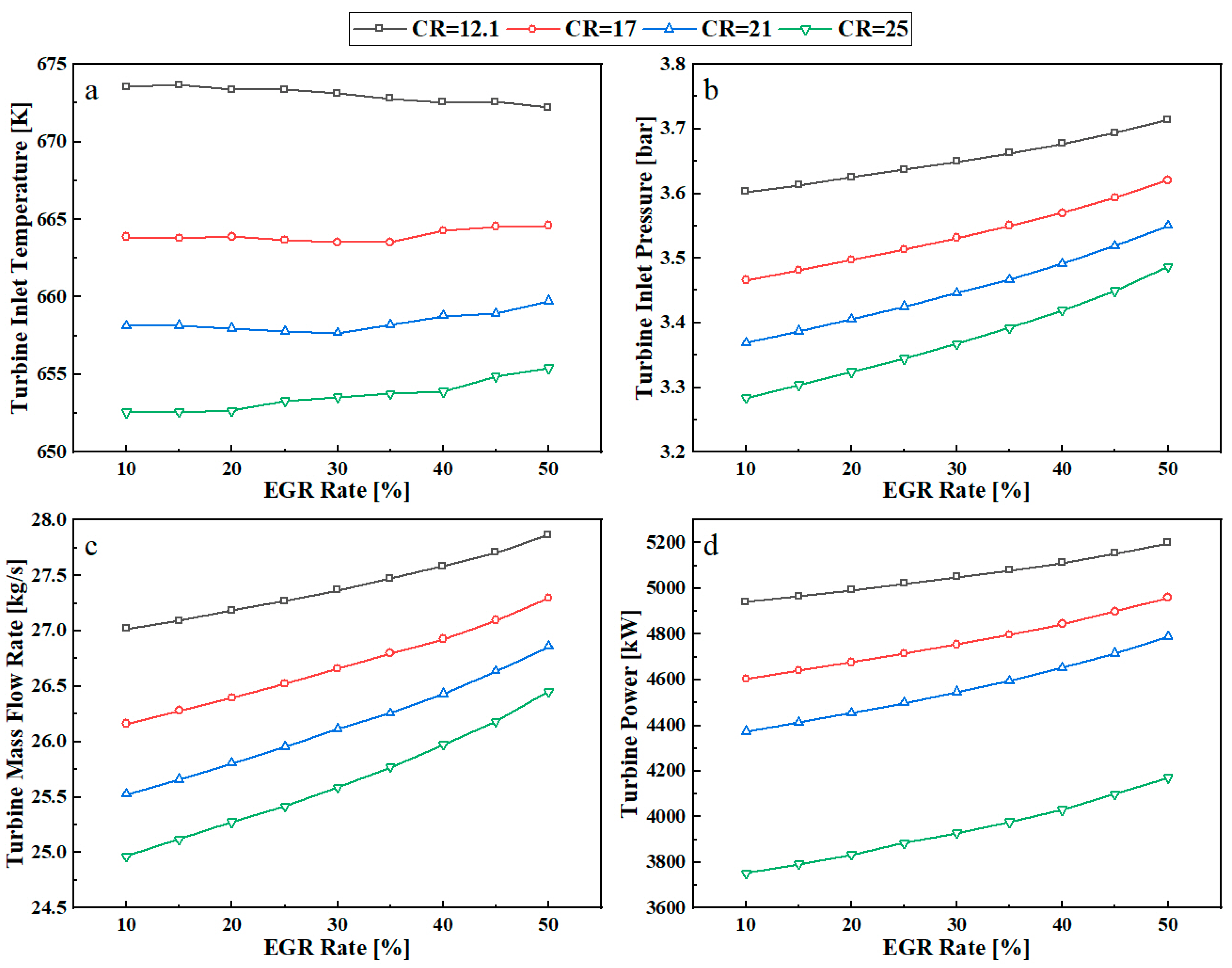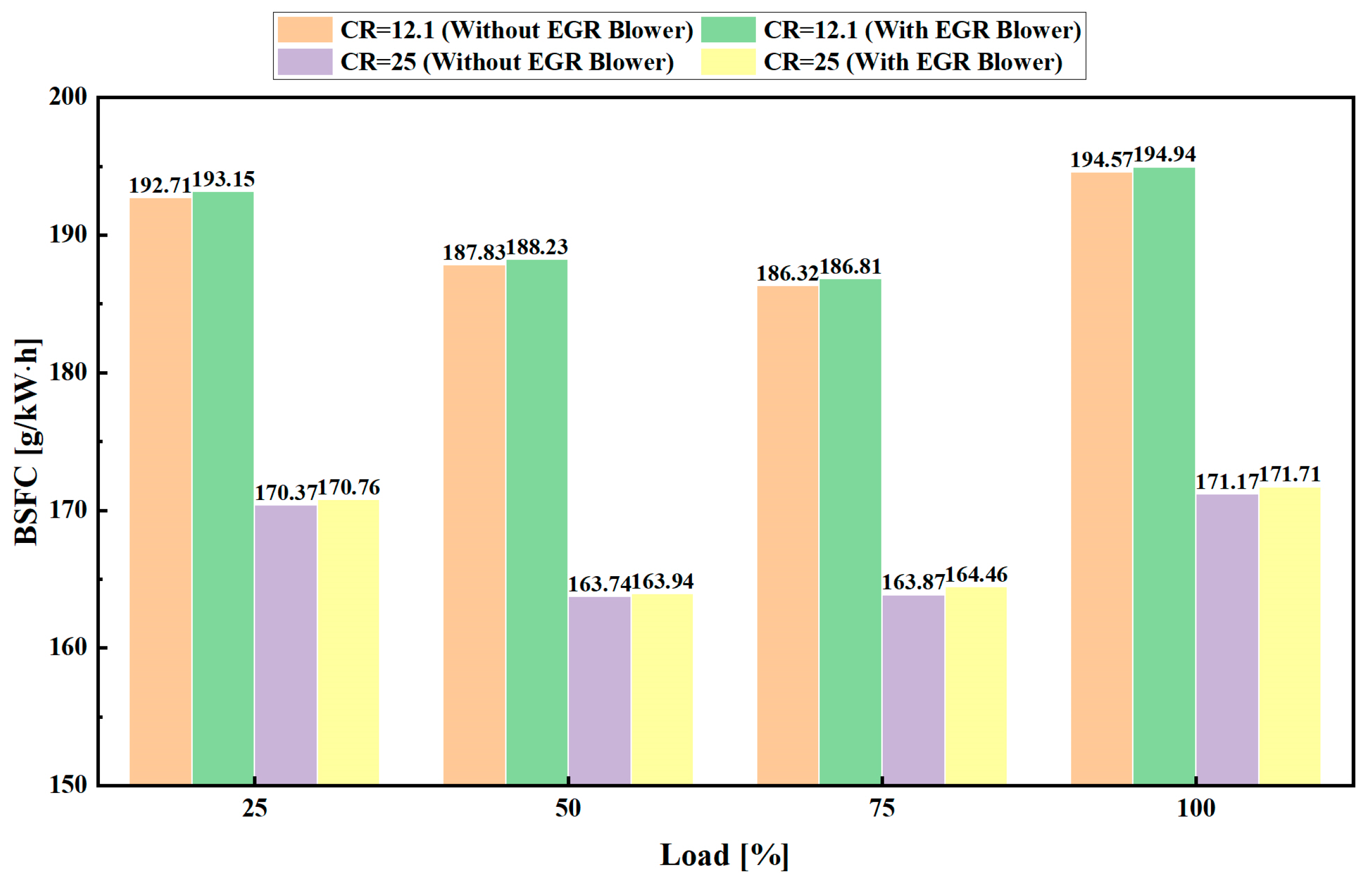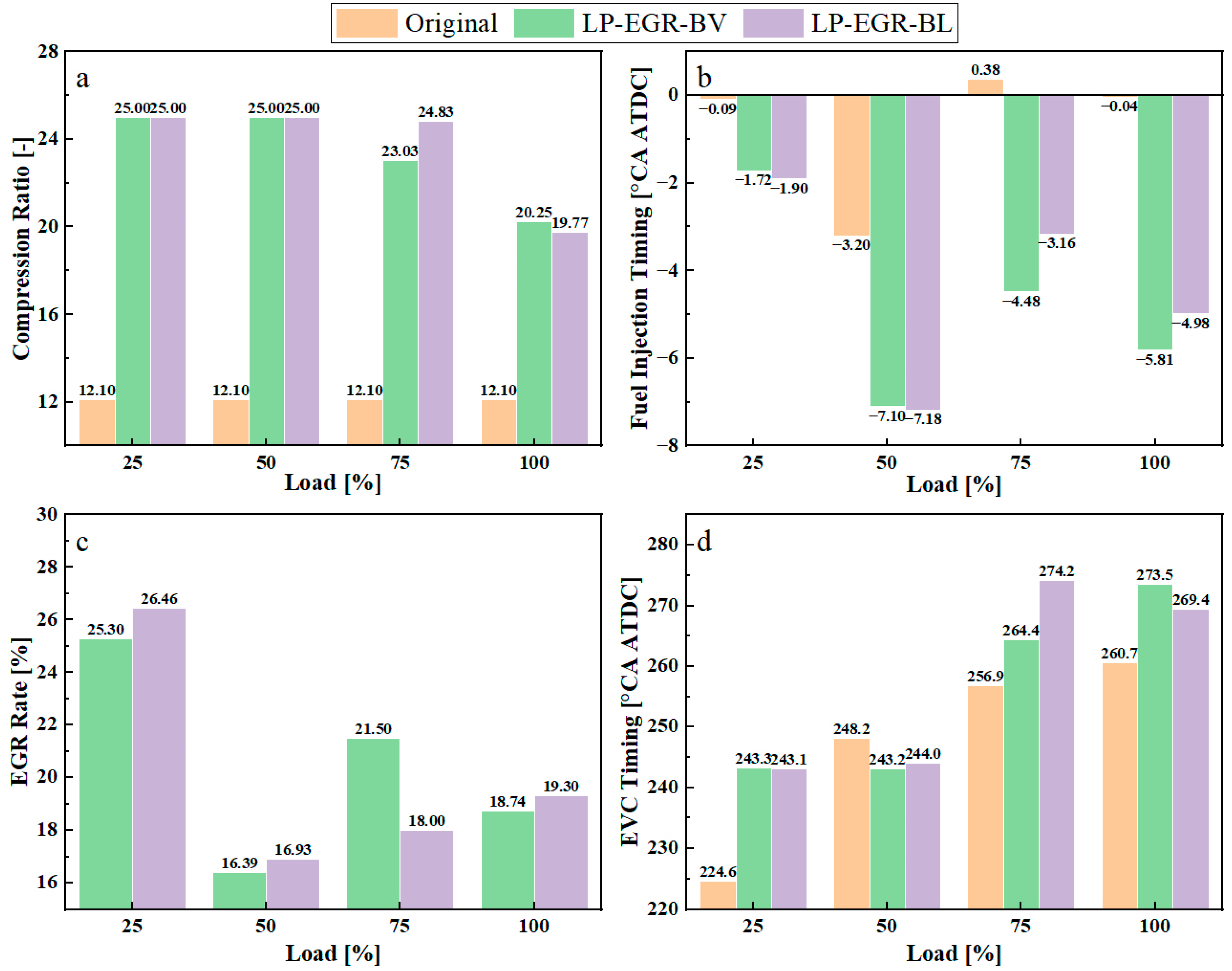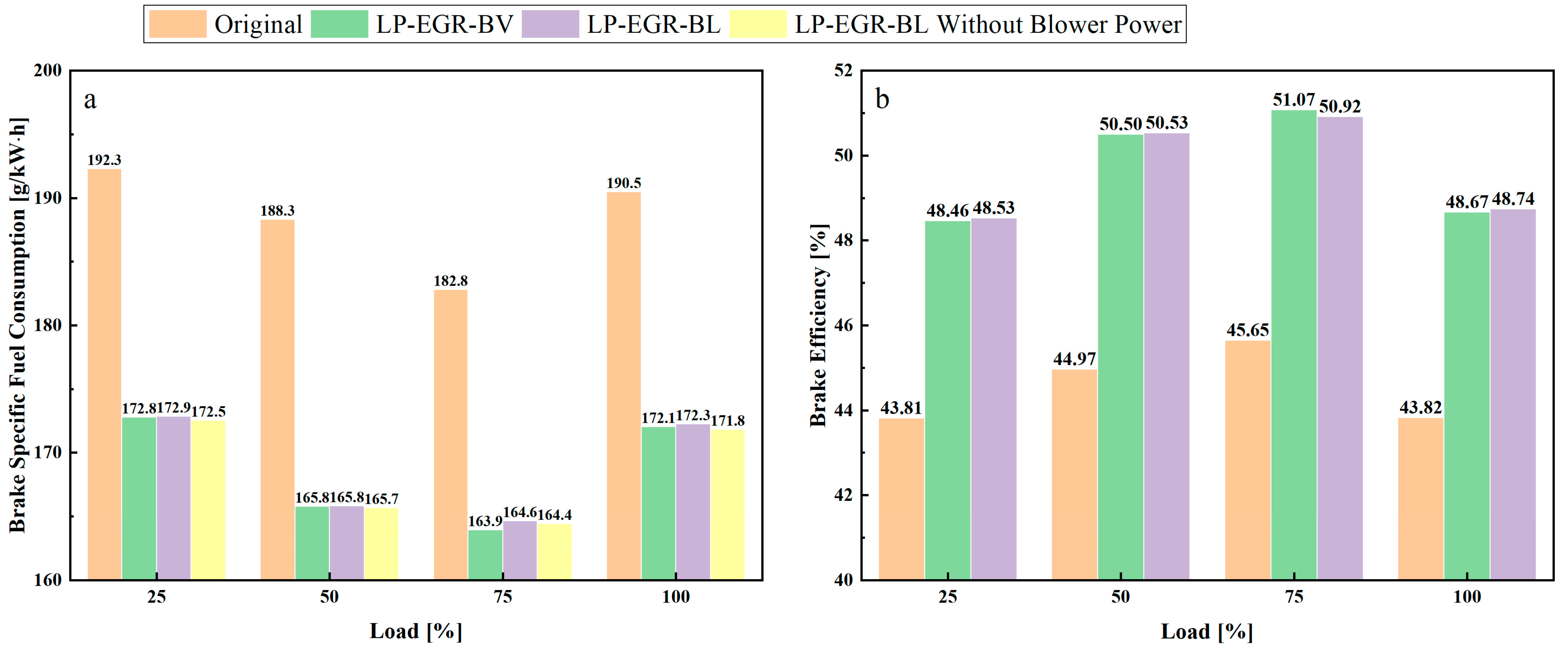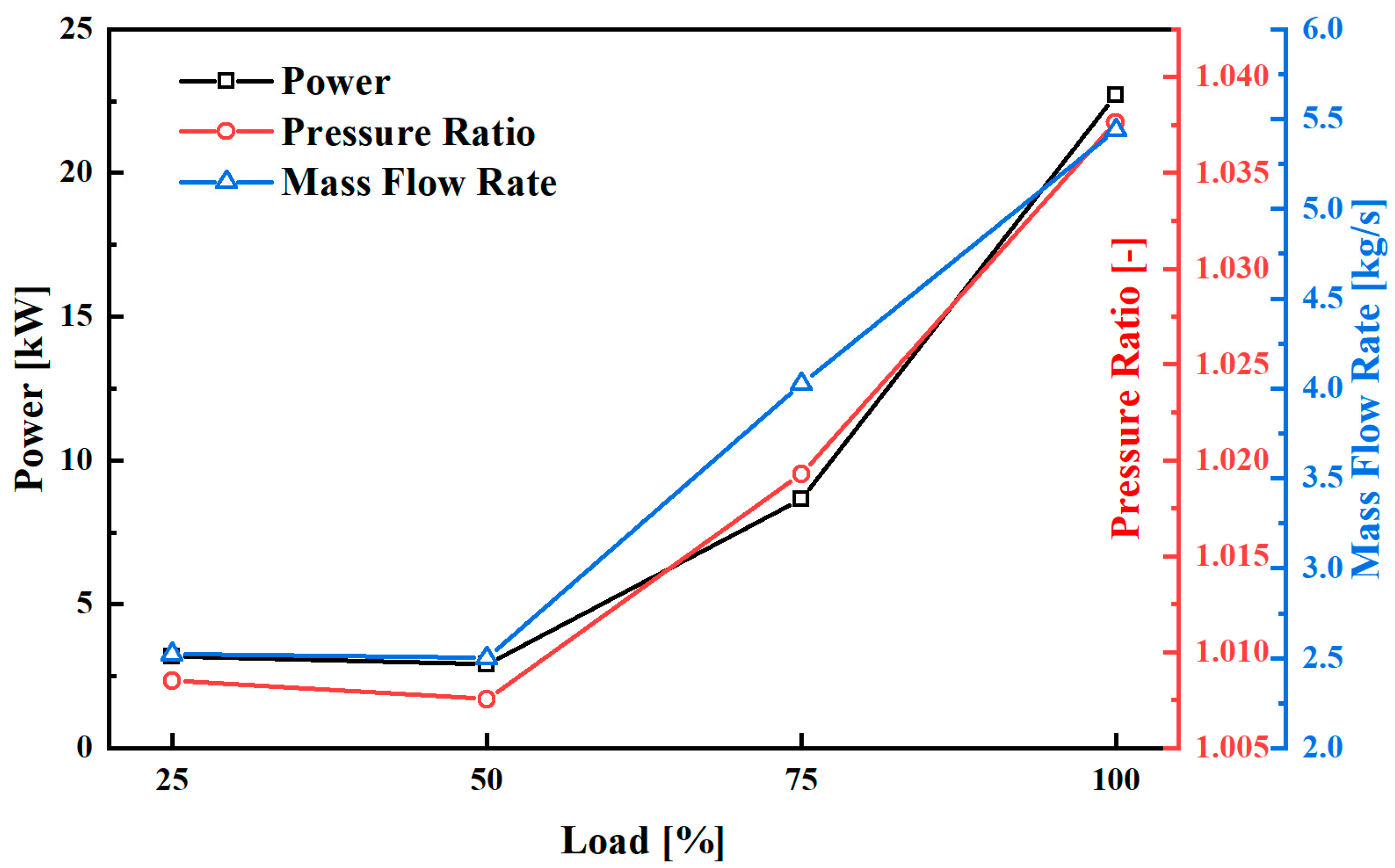1. Introduction
The shipping industry plays an extremely vital role in promoting global economic and trade development due to its merits of high loading capacity, superior safety, and cost-effectiveness [
1]. Nevertheless, the impacts of various gaseous emissions from engines on the ecological environment cannot be ignored. These pollutant emissions mainly include NOx, sulfur oxides (SOx), hydrocarbon (HC), particulate matter (PM), carbon monoxide (CO), and methane (CH
4). In order to alleviate the adverse effects of shipping activities on the environment, corresponding global and regional environmental protection regulations have become stricter. The revised International Convention for the Prevention of Pollution from Ships Annex VI, which was approved at the 58th session of the Marine Environment Protection Committee and came into force on 1 July 2010, establishes International Maritime Organization (IMO) Tier I, Tier II, and Tier III regulations on NOx emissions from marine engines [
2]. For marine engines with a rated speed of less than 130 RPM, the maximum permissible NOx emissions limited by Tier I, Tier II, and Tier III are 17 g/kW·h, 14.4 g/kW·h, and 3.4 g/kW·h, respectively [
3]. Tier I and Tier II are global requirements, which are applied to ships constructed on or after 1 January 2000 and 1 January 2011, respectively. Tier III is applied to ships constructed on or after 1 January 2016, which necessitates a substantial reduction in NOx by around 76% relative to Tier II for ships sailing in the Emission Control Areas (ECAs) [
4]. On 1 January 2020, a newly introduced limit on the sulfur content of the fuel on-board the ships entered into force, namely “IMO 2020” [
5]. The sulfur content is restricted to below 0.50% m/m (mass by mass) for ships sailing outside the ECAs, while the limit is 0.10% within the ECAs. With the global community paying increasing attention to environmental protection, it is reasonable to believe that in the near future, the regulations on pollutant emissions from shipping activities will be even stricter, and more areas will be designated as ECAs.
For compliance with existing mandatory environmental regulations, marine engine manufacturers and researchers have developed various emission-reduction technologies. The regulations on SOx can be simply met by burning either low-sulfur fuel oil or clean fuels. As for the NOx, several feasible technologies have been developed, mainly including EGR, selective catalytic reduction (SCR), Miller cycle, water addition, and fuel injection strategy [
1,
6]. Among these technologies, EGR is widely used by marine engines for meeting Tier III regulations [
7]. Extensive studies have been carried out focusing on the application of EGR in marine diesel engines, which always face the problem of a high level of NOx emissions. These studies cover both LP-EGR and high-pressure EGR (HP-EGR). Extensive experimental investigations of EGR in marine diesel engines have been carried out by marine engine manufacturers, including both shop tests and on-board verification [
8,
9,
10]. It is confirmed by the experimental results that EGR is capable of enabling marine engines to meet Tier III regulations while maintaining the associated fuel penalty within an acceptable range. In addition, many researchers have also carried out relevant studies by using numerical simulation techniques. These studies not only involve using 0-D or 0-D/1-D models to investigate the impacts of EGR on the overall performance of engines, but also include computational fluid dynamics (CFD) models to analyze the effects of EGR on the in-cylinder combustion process and the formation process of various pollutant emissions [
11,
12,
13,
14,
15]. To facilitate the development of the EGR control system, Alegret et al. developed a mean value model of a marine large-scale two-stroke diesel engine equipped with EGR and cylinder bypass valve [
11]. This model demonstrates a fast simulation speed and satisfactory predictive accuracy. Most importantly, it can well capture the main dynamics of the engine. Using a validated 0-D/1-D model, Lu et al. conducted a parametric study on a marine two-stroke diesel engine fitted with EGR and turbocharger cut-out system [
12]. It is found that when the capacity ratio of the large and small turbochargers is set to 70:30, the engine can achieve the lowest weighted BSFC. However, in order to comply with the Tier III regulation, the operation of EGR results in a 2.6% penalty on the weighted BSFC. Also based on a 0-D/1-D model, Wang et al. compared the performances of LP-EGR and HP-EGR in a marine low-speed diesel engine [
13]. With the same in-cylinder peak pressure and the same level of NOx emissions, the power consumptions of both the EGR blower and the engine BSFC with the LP-EGR are lower than that with the HP-EGR. However, it is pointed out that the compactness and cost of the LP-EGR are inferior to those of the HP-EGR. In [
14], a numerical study on the combined application of EGR and Miller cycle was carried out in a marine two-stage turbocharged diesel engine. The results reveal that, compared with using only EGR, combining the two technologies can reduce the NOx emissions and BSFC by 0.87 g/kW·h and 17.19 g/kW·h, respectively. In [
15], based on the CFD model of a marine two-stroke diesel engine, the impacts of EGR, boost pressure, and fuel injection timing were studied. The results reveal that coupling EGR with advanced fuel injection timing can improve the trade-off relationship between NOx emissions and indicated specific fuel consumption. The findings of these previous studies fully demonstrate that EGR is a viable technology that enables marine diesel engines to meet Tier III regulations. However, due to the NOx-BSFC trade-off, the operation of EGR inevitably leads to a deterioration in the engine fuel economy. Although the increase in BSFC is not very significant, considering the characteristics of extremely high power (ranging from several thousand kilowatts to as high as tens of thousands of kilowatts) of marine large-scale diesel engines, the resulting increase in fuel costs cannot be overlooked. This is the reason why, in some studies, EGR is applied in combination with other energy-saving and emission-reduction technologies, such as Miller cycle, fuel injection strategy, and water addition [
14,
15,
16]. The main purpose is to improve the NOx-BSFC trade-off. To fully leverage the potential of EGR in reducing NOx emissions while minimizing the fuel penalty necessitates a collaborative optimization of the EGR rate and other engine setting parameters. For example, a collaborative optimization of EGR and Miller cycle based on PSO was carried out in [
14]; an optimization method combining RSM, Bayesian neural network, and non-dominated sequence genetic algorithm (NSGA) was proposed in [
17]. It should be noted that most of the current research on LP-EGR focuses on the scheme implemented by using the EGR blower (LP-EGR-BL), while there is little research on the scheme implemented by using the back-pressure valve (LP-EGR-BV). The LP-EGR-BV scheme adjusts the engine back-pressure to establish a pressure difference between the turbine outlet and the compressor inlet, thus achieving the recirculation of exhaust gas without consuming any additional power. It is very clear that LP-EGR-BV is superior to LP-EGR-BL in terms of structural complexity, installation space requirement, and cost. Therefore, carrying out relevant research on it holds certain practical significance.
In recent years, marine dual-fuel engines have increasingly gained the favor of shipowners. This type of engine can burn diesel oil in diesel mode and natural gas in gas mode. The carbon content of natural gas is significantly lower than that of diesel oil, and it contains almost no sulfur content, making it an environmentally friendly fuel. Specifically, for marine dual-fuel engines of low-pressure gas injection, the combustion proceeds following the Otto cycle in gas mode. Owing to the lean premixed combustion, an extremely low level of NOx emissions can be achieved, fully meeting Tier III regulations. In contrast, in diesel mode, since the combustion is still the Diesel cycle, only Tier II regulations can be met. For compliance with Tier III regulations in diesel mode, NOx reduction technologies are required. As discussed in [
7], considering that marine dual-fuel engines typically operate in diesel mode only for a limited time, EGR is regarded as a cost-effective technology for the diesel operation to meet Tier III regulations. For marine dual-fuel engines of low-pressure gas injection, in order to avoid knocking in gas mode, a CR much lower than typical marine diesel engines has to be adopted. However, this will greatly sacrifice the engine fuel economy in diesel mode, making BSFC significantly higher than typical marine diesel engines. It can be speculated that the application of EGR will exacerbate this situation. Hence, combining EGR with other technologies is necessary for improving the NOx-BSFC trade-off.
In the field of automotive engines, VCR technology has been proven as a viable solution to improve fuel economy for both compression-ignition diesel engines and spark-ignition gasoline engines. The VCR mechanism of the VC-Turbo engine developed by NISSAN can continuously adjust the CR from 8 to 14 [
18]. When it is installed in the INFINITI QX50 (front-wheel drive specification), compared with the V6 gasoline engine equipped in the former QX50, the fuel efficiency improves by 35%. The findings of the study carried out by Rufino and Ferreira reveal that with variable compression ratio and displacement, an efficiency improvement of around 15% is achieved at part loads for spark-ignition engines [
19]. Similar findings on fuel economy improvement with VCR are also reported in other studies [
20,
21,
22]. Drawing on valuable experience from the existing studies on the application of VCR in automotive engines, VCR is expected to be a promising solution to improve the fuel economy of marine dual-fuel engines of low-pressure gas injection. In diesel mode, the CR can be substantially increased to improve fuel economy, while in gas mode, an appropriate lower CR can be set to avoid knocking. Moreover, in either the diesel or gas mode, a higher CR can be adopted at low loads, while at high loads, a lower CR can be used to avoid exceeding the permissible maximum in-cylinder peak pressure or knocking. In this way, the optimization of engine fuel economy across the entire load range can be achieved. Despite the potential of VCR in improving fuel economy, there are few studies focusing on applying VCR to marine engines. Existing studies mainly focus on investigating how the CR influences the operation of marine engines [
23,
24,
25]. This research gap may be due to the fact that diesel engines still dominate in the field of marine engines and inherently operate without risk of knocking, thus allowing for employing high CR to achieve high engine efficiency. In 2023, WinGD, a world-renowned manufacturer of marine two-stroke engines, introduced VCR technology for marine two-stroke dual-fuel engines of low-pressure gas injection [
26]. However, more detailed specifics and performance characteristics of this technology have not been found in the literature or news reports.
Based on the introduction and discussion of existing research presented above, the combination of EGR and VCR appears to be a highly effective solution for enabling marine dual-fuel engines of low-pressure gas injection to comply with Tier III while achieving satisfactory fuel economy in diesel mode. This constitutes the primary topic of this study.
Through the above analysis, corresponding research gaps can be identified. Although extensive studies, both experimental and simulation ones, have been conducted to analyze and investigate the effects of EGR or VCR on engine performance and emission characteristics, little research has been carried out on the combined application of EGR and VCR in internal combustion engines, especially marine large-scale engines. In some existing studies [
13,
27,
28], while the performances of different EGR configurations have been compared, generally speaking, they are only limited to the comparison between LP-EGR and HP-EGR. There is a lack of studies comprehensively comparing LP-EGR schemes implemented with either a back-pressure valve or EGR blower, respectively (for the sake of brevity, these two types of LP-EGR are designated as LP-EGR-BV and LP-EGR-BL in this paper). To better inform the real-world design choices of both ship owners and engine manufacturers, it is necessary to conduct targeted studies to fill the abovementioned research gaps.
The novelty of this study includes the following: (a) A technical route, namely LP-EGR combined with VCR, is proposed to address the inferior fuel economy of marine dual-fuel engines of low-pressure gas injection in diesel mode. (b) A meticulous engine performance optimization strategy based on RSM-PSO is designed to fully exploit the potential of combining LP-EGR and VCR in terms of energy conservation and emission reduction. (c) A systematic comparison is made between the LP-EGR-BV and LP-EGR-BL schemes, including a quantitative comparison of their impacts on the engine performance, as well as a qualitative comparison in terms of structural complexity, initial costs, maintenance costs, etc.
The main purpose of this study is to validate the applicability of combining LP-EGR and VCR in a marine two-stroke dual-fuel engine through numerical simulations, aiming to minimize the BSFC while complying with the Tier III regulations on NOx emissions. Firstly, a 0-D/1-D simulation model of the target engine is developed using commercial engine simulation software GT-Power (Version 2020). After carefully calibrating the model parameters, this type of model is capable of providing accurate prediction results without requiring extensive computational efforts [
29,
30]. This feature is very suitable for investigating the whole-engine performance. Furthermore, aiming at the purpose of this study, the predictive combustion model DI-Pulse is selected to simulate the in-cylinder combustion process due to its capability of capturing the impacts of the variations in EGR rate and CR on the combustion characteristics. Secondly, parametric investigations are performed to identify the combined impacts of EGR rate and CR on the combustion process, turbocharging system, and NOx-BSFC trade-off. This step is crucial for formulating a reasonable optimization strategy, including the selection of optimization variables and determination of constraint conditions. Then, based on a comprehensive consideration of the study’s purpose and various factors influencing the safe, stable, and continuous operation of the engine, the optimization strategy is formulated, which is defined as a constrained single-objective optimization problem. Finally, an optimization program based on RSM-PSO is developed. Similar methodologies have been adopted in many studies on engine optimization [
31,
32,
33]. Optimization results are derived to evaluate and compare the performances of the two LP-EGR schemes in terms of improving the fuel economy. In addition, a short discussion is presented on how the findings of this study inform real-world design decisions from the perspectives of commercialization potential, cost-effectiveness, and reliability.
6. Informing on Real-World Design Decisions
In this section, how the findings of this study inform real-world design decisions is explored mainly from three perspectives, namely commercialization potential, cost-effectiveness, and reliability, which are of significant concern to both ship owners and engine manufacturers.
The results presented in
Section 5 demonstrate that the combination of LP-EGR and VCR can effectively improve the fuel economy of the marine dual-fuel engines of low-pressure gas injection in diesel mode; meanwhile, Tier III regulations can be fully met. It is also expected that satisfactory energy-saving and emission-reduction effects can be achieved when operating in gas mode. This is highly attractive to shipowners. Furthermore, considering that the EGR technology is already highly mature in the marine engine sector and WinGD’s VCR technology has gradually entered commercialization, the technical route proposed in this study, namely LP-EGR combined with VCR, is technically feasible and holds significant commercial potential.
To evaluate the cost-effectiveness of the proposed technical route, consider the following scenario: a ship with the engine investigated in this study as its propulsion plant operates a total 7000 h annually. The navigation durations at 25%, 50%, 75%, and 100% MCR are 1050 h, 1050 h, 3500 h, and 1400 h, respectively. The fuel used is marine diesel oil priced at USD 430 per ton [
37].
Table 7 provides the estimated annual fuel consumption and fuel cost for the original engine and the two LP-EGR schemes. As shown in this table, compared to the original engine, both LP-EGR schemes achieve an approximate reduction of 1200 tons in annual fuel consumption and save annual fuel costs by over USD 500,000. Even if it is assumed that the engine operates in diesel mode for only one-fifth of its lifetime, the corresponding annual fuel consumption and fuel costs can be saved by approximately 240 tons and USD 100,000, respectively. Assuming a ship’s lifecycle of 20 years, the total fuel cost savings would exceed USD 2 million. Taking into account that the gas mode will also benefit from the application of the proposed technical route, the corresponding savings in fuel costs will be more substantial. Compared to the initial and maintenance costs of the LP-EGR and VCR mechanisms, the reduction in fuel costs is substantial, thus confirming that the technical route proposed in this study offers highly attractive cost-effectiveness.
EGR technology has been utilized in marine engine applications for over ten years, and its reliability has been thoroughly demonstrated through extensive real-world operational experience [
8,
9,
10]. However, VCR technology has only recently begun to be commercialized in the field of marine engines. Considering that the VCR mechanism is continuously subjected to high pressure arising from the in-cylinder combustion, this poses substantial challenges to the mechanical strength, operational stability, and sealing integrity of the hydraulic driving system. Therefore, the reliability of VCR technology still requires further on-board tests.
7. Conclusions
In this paper, a numerical study was carried out to investigate the applicability of LP-EGR combined with VCR in improving the fuel economy of marine two-stroke dual-fuel engines of low-pressure gas injection in diesel mode. The main findings are summarized as follows:
Compared with the LP-EGR-BV scheme, a higher in-cylinder pressure level can be obtained with the LP-EGR-BL scheme but at the cost of additional power consumed by the EGR blower. Nevertheless, due to the low exhaust gas pressure in the LP-EGR system, the increase in BSFC caused by the operation of EGR blower does not exceed 1 g/kW·h.
Although the two LP-EGR schemes exhibit completely opposite impacts on the turbocharging system, the compressor can achieve a satisfactory efficiency. At 25% MCR, the compressor efficiency remains around 80% and 81% for LP-EGR-BV and LP-EGR-BL schemes, respectively. At 50%, 75%, and 100% MCR, it stays approximately 84% for LP-EGR-BV, while it ranges between 83% and 85% for LP-EGR-BL. The surge margin is also maintained within the reasonable range. Furthermore, an adequate quantity of scavenging air can be provided to ensure that the injected fuel burns completely. This fully demonstrates that the existing turbocharging system can be well matched with LP-EGR and VCR, and there is no need for re-matching. This is crucial for the renovation and upgrading of existing engines.
The optimization results reveal that the two LP-EGR schemes are capable of achieving a similar improvement in fuel economy. For the LP-EGR-BV scheme, compared with the baseline engine, the optimized BSFC decreases by 10.16%, 11.95%, 10.32%, and 9.68% at 25%, 50%, 75%, and 100% MCR, respectively, whereas, for the LP-EGR-BL scheme, the optimized BSFC decreases by 10.11%, 11.93%, 9.93%, and 9.58%, respectively. Furthermore, after optimization, the level of NOx emissions improves from only meeting the Tier II regulations (14.4 g/kW·h) to being able to meet the Tier III regulations (3.4 g/kW·h).
The results of the qualitative analysis indicate that the LP-EGR-BV scheme is superior to the LP-EGR-BL scheme in terms of structural complexity, initial cost, maintenance cost, installation space requirement, and power consumption. Only considering the above aspects, LP-EGR-BV is a more promising solution. However, a further in-depth study is needed to compare the two LP-EGR schemes in terms of dynamic performance, response speed, control accuracy, and reliability.
The technical route proposed in this study demonstrates considerable economic benefits. Even if it is assumed that the investigated dual-fuel engine operates in diesel mode for only one-fifth of its lifetime, the corresponding annual fuel consumption and fuel cost will be saved by approximately 240 tons and USD 100,000, respectively. This is very attractive to shipowners.
The findings of this research confirm that the combination of LP-EGR and VCR can effectively enhance the fuel economy of marine dual-fuel engines of low-pressure gas injection in diesel mode while complying with the Tier III regulations on NOx emissions. In addition, it is also expected that the technical route presented in this study provides valuable insights for optimizing the performance and emissions of automotive and large-scale power generation engines.
Although encouraging results were obtained in this study by numerical simulation, the adopted 0-D/1-D modeling approach still has limitations that cannot be ignored. First of all, it is difficult for the 0-D/1-D approach to accurately predict the combined impacts of EGR and VCR on the engine pollutant emissions including HC, CO, and PM, which, like NOx, are also important for evaluating the performance of the engine emission characteristics. In addition, limited by the predictive ability of the 0-D/1-D approach, it is impossible to comprehensively analyze the dynamic characteristics of the in-cylinder flow field. Secondly, when establishing the 0-D/1-D engine simulation model in GT-Power, in order to reduce the model complexity, necessary simplifications and assumptions are made. This is highly likely to result in deviations between the final optimization results and actual results, which cannot be overlooked.
After fully recognizing the limitations of the 0-D/1-D modeling approach adopted in this study, the direction of future research can also be preliminarily determined. Combined with the 0-D/1-D simulation results, CFD simulation research should be conducted to comprehensively evaluate the impacts of the combination of EGR and VCR on engine power, economic, and emission characteristics. At the same time, the relevant underlying mechanisms must be understood to fully exploit the potential of the combination of EGR and VCR in terms of energy conservation and emission reduction. If the experimental conditions permit, statistical analysis will be conducted to validate the significance of the improvements observed in this study. In addition, this study only focuses on the diesel mode of the investigated marine dual-fuel engine. In future research, the applicability of EGR combined with VCR in gas mode will be explored by extending the established 0-D/1-D engine model. This will require incorporating models of the pre-chamber, natural gas admission valve, pilot fuel injector, and adopting a predictive combustion model tailored for jet-ignition natural gas engines.

